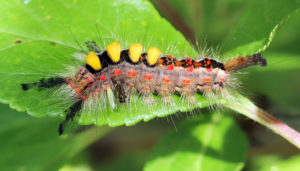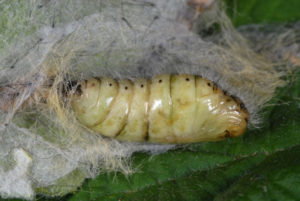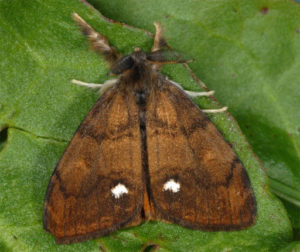Rusty Tussock Moth (Orgyia antiqua)
The rusty tussock moth is an Erebidae moth. Swedish zoologist Carl Linnaeus first described this species in 1758.
butterfly-conservation.org
Scientific Classification
- Family: Erebidae
- Genus: Orgyia
- Scientific Name: Orgyia antiqua
Description and Identification
Caterpillar
The color of the larva’s body ranges from a dark gray to black, with red tubercles visible on its back and sides. Their most recognizable feature is their setae, which are projected in the form of horn-like tufts. There are four of them shaped like toothbrushes along the back, while the entire body is covered with hair pencils on all sides. These setae also absorb toxins from the caterpillar’s defensive glands acting as a form of defense. However, they are not poisonous, at worst leaving behind an itchy rash.
Larvae reach up to lengths of 40mm, with the females being considerably larger.
Adult Moth
Sexual Dimorphism: Present.
The female is completely flightless, remaining attached to her cocoon throughout her life, while the males are capable of flight.
Color and Appearance
Forewing: When open, they are red-brown with a large white spot shaped like a comma in the post-median area. The spot remains visible when the wings are closed.
Hindwing: When open, the color of these wings ranges from red-orange to orange-brown. When closed, the patterns are no longer visible.
Average wingspan: 35-38 mm
Flight pattern: Zigzagged, sometimes even high up from the ground while tracking females with the help of her pheromones.
Season: Late Summer to Fall
Quick Facts
| Other Names | Vapourer Moth |
| Distribution | Native: Europe Invasive: North America, parts of Africa and Asia |
| Habitat | Fens, gardens, heaths, hedgerows, moors, open woodlands, and parks. |
| Lifespan of Adults | Males: A few days Females: Around 1 week |
| Host Plants | Several different trees and shrubs, including birch, hawthorn, lime, oak, pinwheel, Sitka spruce, and willow |
| Adult Diet | Does not feed |
Scientific Classification
- Family: Erebidae
- Genus: Orgyia
- Scientific Name: Orgyia antiqua









